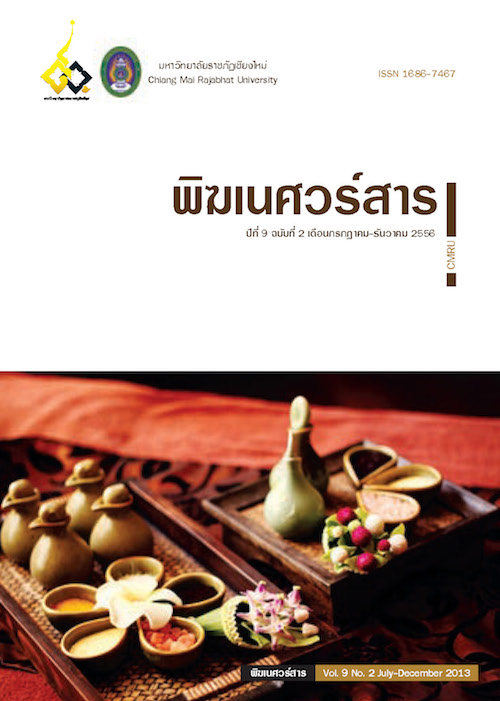การจัดการเรียนรู้เพื่อส่งเสริมศักยภาพของกลุ่มเป้าหมายเฉพาะในหมู่บ้านคลองโยง ตำบลคลองโยง อำเภอพุทธมณฑล จังหวัดนครปฐม
Main Article Content
Abstract
การวิจัยครั้งนี้เป็นการวิจัยเชิงปฏิบัติการอย่างมีส่วนร่วม (Participatory Action Research) มีวัตถุประสงค์เพื่อ 1) ศึกษาสภาพชุมชนและศักยภาพของกลุ่มเป้าหมายเฉพาะ ประกอบด้วยกลุ่มคนต่างวัยและกลุ่มผู้พิการในตำบลคลองโยง และ 2) จัดการเรียนรู้ตามศักยภาพของกลุ่มเป้าหมายเฉพาะ ประกอบด้วยกลุ่มคนต่างวัยและกลุ่มผู้พิการในตำบลคลองโยง การเก็บรวบรวมข้อมูลใช้การวิเคราะห์ สังเคราะห์เนื้อหา เทคนิค A-I-C (Appreciation Influence Control) รวมทั้งใช้แบบสอบถาม แบบสัมภาษณ์ และการเยี่ยมบ้าน เลือกกลุ่มเป้าหมายแบบเฉพาะเจาะจง (Purposive Sampling) ประกอบด้วย กลุ่มผู้สูงอายุจำนวน 30 คน กลุ่มคนวัยทำงานจำนวน 15 คน กลุ่มเด็กและเยาวชนจำนวน 20 คน และกลุ่มผู้พิการจำนวน 5 คน การวิเคราะห์ข้อมูลเชิงปริมาณใช้สถิติเชิงพรรณนา (Descriptive Statistic) และการวิเคราะห์เชิงคุณภาพใช้การวิเคราะห์เนื้อหา
ผลการวิจัยสรุปได้ดังนี้
ตำบลคลองโยง เป็นหนึ่งในสามตำบลคือ คลองโยง ศาลายา และมหาสวัสดิ์ ของอำเภอพุทธมณฑล จังหวัดนครปฐม ที่สมัยก่อนประชาชนส่วนใหญ่สัญจรไปมาอาศัยแม่น้ำท่าจีนและคลองแยกเชื่อมแม่น้ำท่าจีนโดยอาศัยเรือเป็นพาหนะ พ่อค้าได้ใช้เรือโยงติดต่อกันหลายๆ ลำในการขนสินค้าผ่านคลองนี้ เพื่อออกแม่น้ำท่าจีน ชาวบ้านจึงเรียกตำบลนี้ว่า “คลองโยง”
จากการศึกษากลุ่มเป้าหมายเฉพาะแสดงผลสรุปดังนี้
กลุ่มผู้สูงอายุ มีปัญหาด้านสุขภาพ ต้องการการออกกำลังกายประกอบดนตรีไทย (ดนตรี,กีฬา) การนวดแผนโบราณ และงานประดิษฐ์ ศักยภาพของกลุ่มคือความสามัคคี ความรู้ประวัตศาสตร์ชุมชน เล่นดนตรีไทย จัดกิจกรรมเรียนรู้ในการดูแลตนเองด้านอาหาร อวัยวะสำคัญ และการพับผ้าเช็ดหน้า กลุ่มคนวัยทำงานซึ่งส่วนใหญ่เป็นเกษตรกร ปัญหาที่พบว่ารุนแรงและต้องการการแก้ไข ได้แก่ เรื่องเมล็ดพันธุ์ข้าวปนคือข้าวดีดเป็นข้าวที่ไม่ให้ผลผลิต ศักยภาพของกลุ่มพบว่ามีแกนนำที่มีความรู้ในพื้นที่ ช่วยเหลือให้การประสานงานเป็นไปอย่างดี เกษตรกรทุกครัวเรือนอยู่ในพื้นที่ที่ได้รับโฉนดชุมชนเป็นแห่งแรก ทำให้มีพื้นที่เกษตรกรรมเป็นของตนเอง มีความร่วมมือจัดกิจกรรมการเรียนรู้โดยให้ความรู้กับผู้นำและเกษตรกรรายย่อยเกี่ยวกับพันธุ์ข้าว และปัญหาข้าวดีด และการนำข้าวดีดมาแปรรูปเป็นข้าวยาคู กลุ่มเด็กและเยาวชน ชุมชนต้องการให้เด็กมีจิตอาสาและการเรียนรู้วัฒนธรรม เด็กสามารถอ่านและเขียนได้บ้างในเด็กโต เด็กบางคนเคยผ่านโครงการมัคคุเทศก์น้อย มีพิพิธภัณฑ์ท้องถิ่นวัดมะเกลือเป็นแหล่งเรียนรู้ ผู้ปกครองพระ และชุมชนสนับสนุนให้ความร่วมมือจัดกิจกรรมการเรียนรู้ ได้แก่ นักวิจัยน้อยเรียงร้อยภูมิปัญญาท้องถิ่น ผู้เฒ่าเล่าขาน ลูกหลานเรียนรู้ เชิดชูบ้านมะเกลือ เด็กพาเดิน เพลิดเพลินเรียนรู้สิ่งดีๆ ที่มีอยู่ และจัดทัศนศึกษาที่วัดขนอน (หนังใหญ่) พิพิธภัณฑ์วัดม่วง และพิพิธภัณฑ์หุ่นขี้ผึ้งสยาม กลุ่มผู้พิการที่เป็นกลุ่มตัวอย่างเป็นเครือญาติกันจำนวน 5 ราย พิการทางการได้ยินทั้งหมด และมีบางรายที่มี ความพิการซ้ำซ้อนคือพิการทางจิตร่วมด้วย ผู้พิการในครอบครัวนี้ได้รับเงินยังชีพคนละ 500 บาทต่อเดือน แต่ยังมีความต้องการการดูแลคุณภาพชีวิต กิจกรรมการเรียนรู้คือ การให้คำแนะนำผู้ดูแลระหว่างการเยี่ยมบ้าน จัดทำแผ่นพับความรู้พระราชบัญญัติสิทธิประโยชน์ที่พึงได้รับของผู้พิการ และแผ่นพับความรู้การป้องกันความพิการรายบุคคลและชุมชน
ORGANIZING A LEARNING PROCESS FOR SPECIFIC TARGET GROUPS TO ENHANCE THEIR POTENTIAL : TAMBON KLONGYONG, AMPHUR PHUTTHAMONTHON, NAKHON PATHOM PROVINCE
This participatory action research aimed to 1) study community conditions and the target group’s potentiality consisting of different age groups and disabilities in Khlongyong sub-district and 2) conduct learning management potential of the different age groups and disabilities in Khlongyong sub-district.
Data was collected by content analysis, synthesis, and A-I-C (Appreciation Influence Control) technique. Questionnaire and interviews were used as research tools. Purposive sampling method was used with 30 elders, 15 working age group people, 20 youngsters, and 5 people with disabilities. Descriptive analysis was used to analyze the contents.
The research findings can be concluded as follows:
Khlongyong sub-district is one of the 3 sub-districts: Khlongyong, Salaya, and Mahasawat of Buddhamonthon district in Nakhonpathom province. In the past, people commuted through Thajeen river and canals linked to Thajeen river by boat. Merchandisers used several boats to carry goods through these canals to Thajeen river. Therefore, it has been called “Khlongyong”. And the findings for each target group are as follows:
It was found health problems of Elders. They needed exercises such as Thai music dance, Thai traditional massage, and inventions. The potentialities of the group were harmony, knowledge of the community, ability to play Thai musical instruments, learning management of self-prevention on diet, body parts, and handkerchief folding. The serious problem found in working-age group and solution needed was the lack of good rice seeds. They made less produce because of the weedy rice. The potentiality of the group was that they had knowledgeable people in the area who assisted and helped with coordinating work. Every family had their own the first land title deed. Therefore, they had their own land to do the farming. They cooperated and took part in activities to help solve the problem in the community. The learning knowledge activities approached to the leaders and the head of the agricultural families about rice varieties problems and how to appropriate weding to Yagu Rice. The children, do volunteering work, and learn culture. Some young adults were able to read and write. Some children were trained in being young guides. The learning center was at Wat Maklua Museum with the supports from parents, monks, and the community. The learning activities included young researchers, elders telling stories to youngsters, Ban Maklua support, walking tour by the children, and educational tour at Wat Khanon, Wat Muang museum, and Siam Wax museum in Photharam, Ratchaburi province. The disabilities sample group included 5 people with disabilities who were relatives. They all had hearing disabilities. Some of them had both multiple disabilities and mental disabilities. Each disabled in this family received 500 baht as a living support budget per month, but he still needed more life quality caring. There was only one from three people with disabilities who could work as a worker in lotus fields. Learning activities for people who looked after the disabled when visiting their houses. There were brochures about law and rights for people with disabilities and brochures regarding prevention from being disabled for individuals and community.
Downloads
Article Details
The articles published are copyrighted by the Graduate School, Chiang Mai Rajabhat University.
The opinions expressed in each article of this academic journal are solely those of the individual authors and do not reflect the views of Chiang Mai Rajabhat University or its faculty members. The responsibility for the content of each article rests entirely with the respective authors. In the event of any errors, the authors alone are responsible for their own articles.


